Mid AlgoExp - 6-15
6- Longest Peak
Write a function that takes in an array of integers and returns the length of
the longest peak in the array.

Javascript Solution
As you can see you first fit the the peak, and then start extending the peak sides (That's whjy it starts from the left to the right. which goes increasing or decreasing)
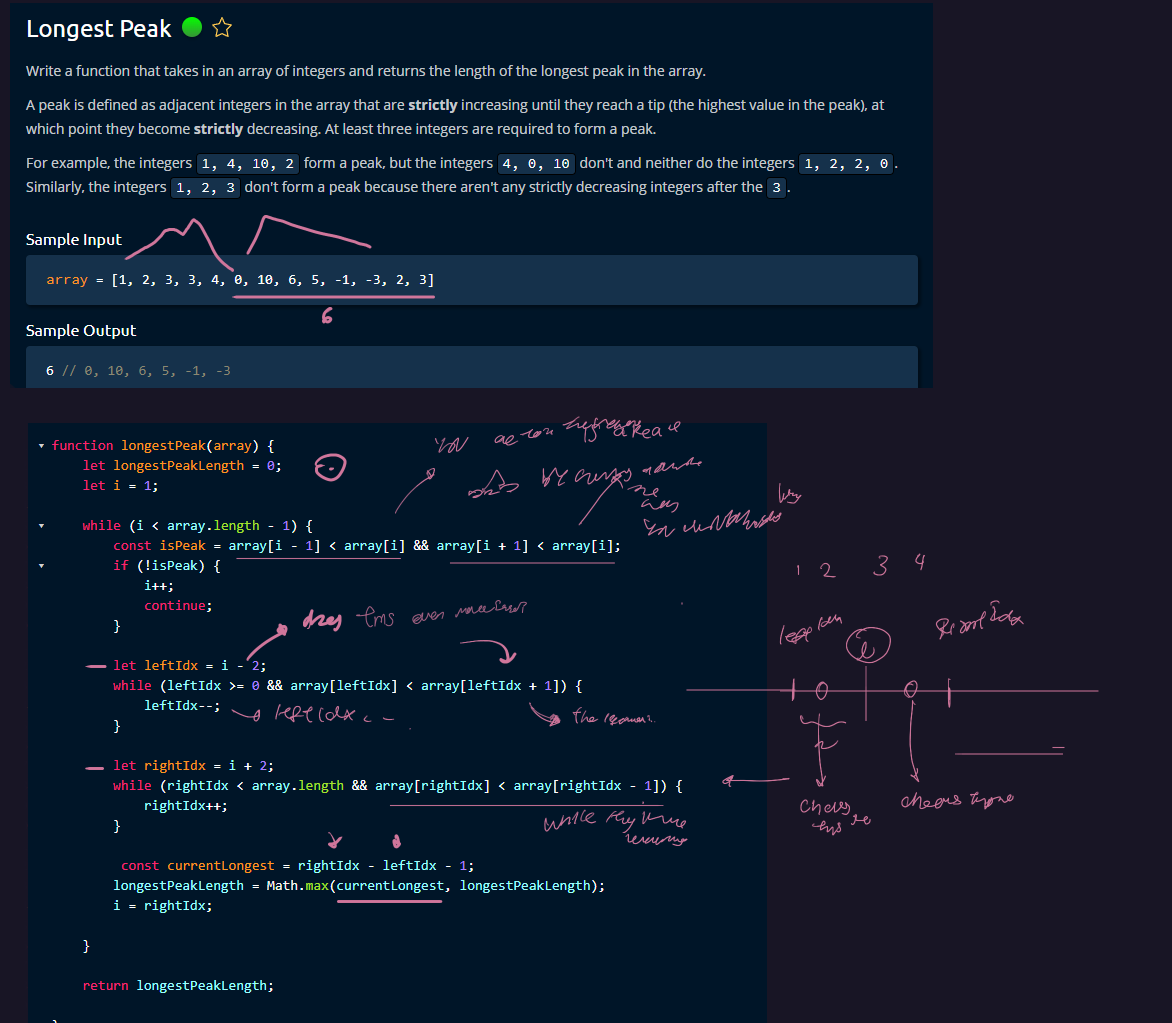
function longestPeak(array) {
let longestPeakLength = 0;
let i = 1;
while (i < array.length - 1) {
const isPeak = array[i - 1] < array[i] && array[i + 1] < array[i];
if (!isPeak) {
i++;
continue;
}
let leftIdx = i - 2;
while (leftIdx >= 0 && array[leftIdx] < array[leftIdx + 1]) {
leftIdx--;
}
let rightIdx = i + 2;
while (rightIdx < array.length && array[rightIdx] < array[rightIdx - 1]) {
rightIdx++;
}
const currentLongest = rightIdx - leftIdx - 1;
longestPeakLength = Math.max(currentLongest, longestPeakLength);
i = rightIdx;
}
return longestPeakLength;
}
7 - Array of Products
Write a function that takes in an array of integers and ran array of the same length, where each element in the output array is equal to the product of every other number in the input array
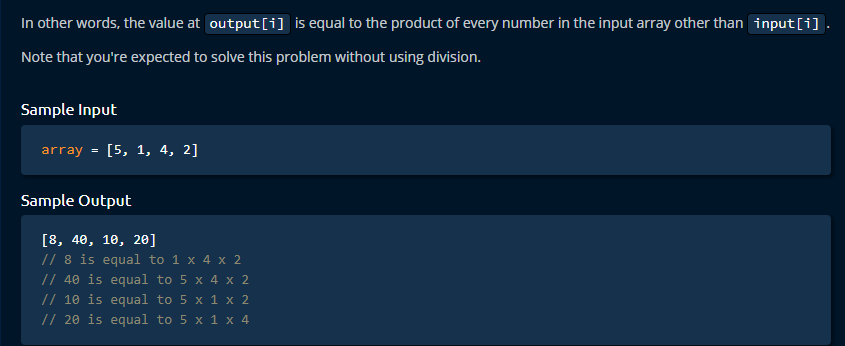
Javascript Solution
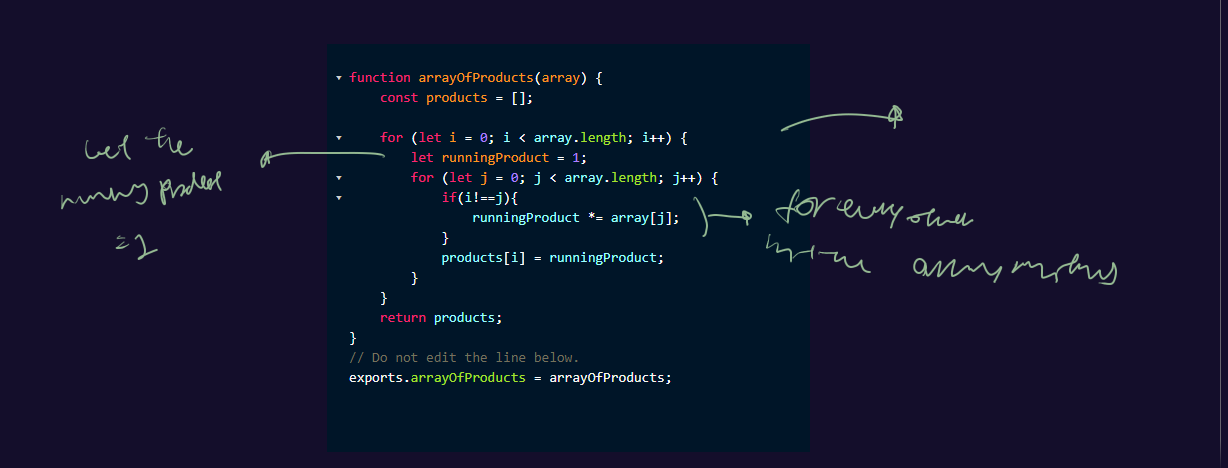
SO this solution is actually very simple, a nested loop with a ignore case if the i = j so it skips multiplying tiself.
function arrayOfProducts(array) {
const products = [];
for (let i = 0; i < array.length; i++) {
let runningProduct = 1;
for (let j = 0; j < array.length; j++) {
if(i!==j){
runningProduct *= array[j];
}
products[i] = runningProduct;
}
}
return products;
}
// Do not edit the line below.
exports.arrayOfProducts = arrayOfProducts;
The o(n) solution is a little more interesting, this one o(n) solution bases on the following clue: we can get all the multiplication in the right and the multiplications of all the values in the left we can get the multiplication of all the values except for the one there:
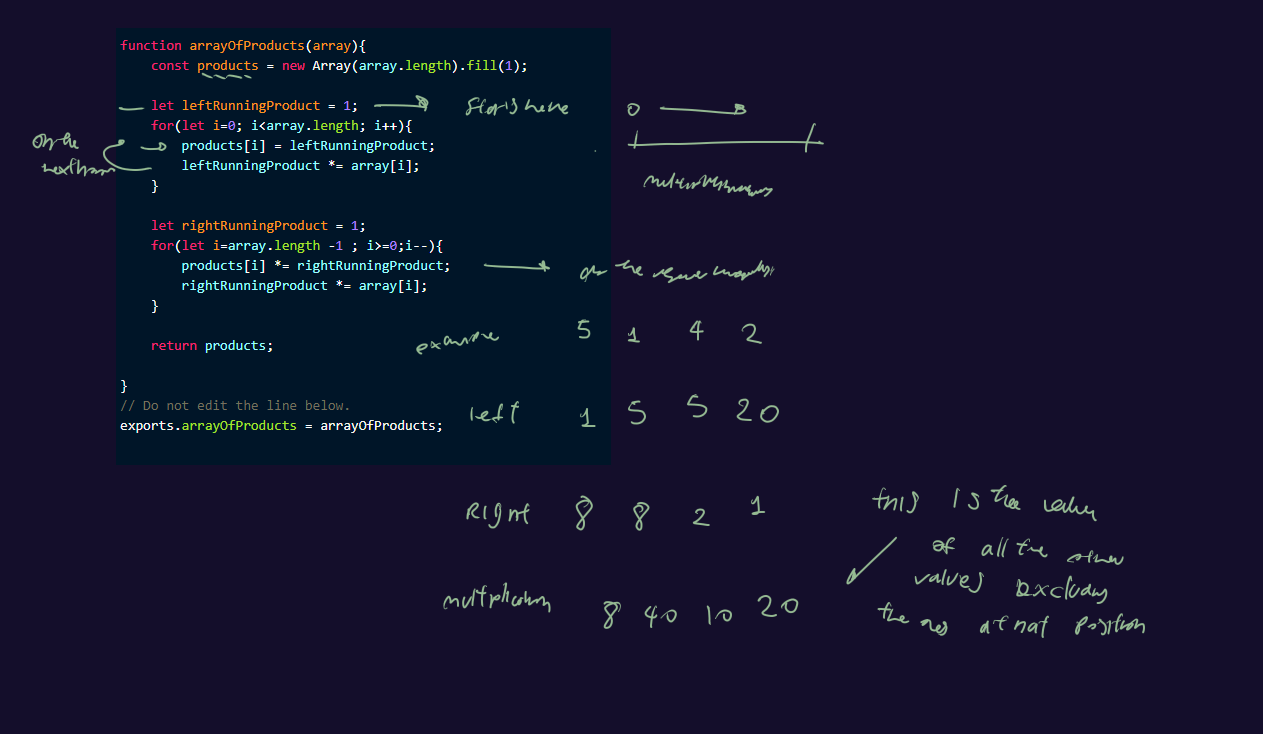
function arrayOfProducts(array){
const products = new Array(array.length).fill(1);
let leftRunningProduct = 1;
for(let i=0; i<array.length; i++){
products[i] = leftRunningProduct;
leftRunningProduct *= array[i];
}
let rightRunningProduct = 1;
for(let i=array.length -1 ; i>=0;i--){
products[i] *= rightRunningProduct;
rightRunningProduct *= array[i];
}
return products;
}
8 - First Duplicate Value
Given an array of integers between a and n, inclusive, where n is the
length of the array, write a function that returns the first integer that
appears more than once. (when the array is read from left to right)
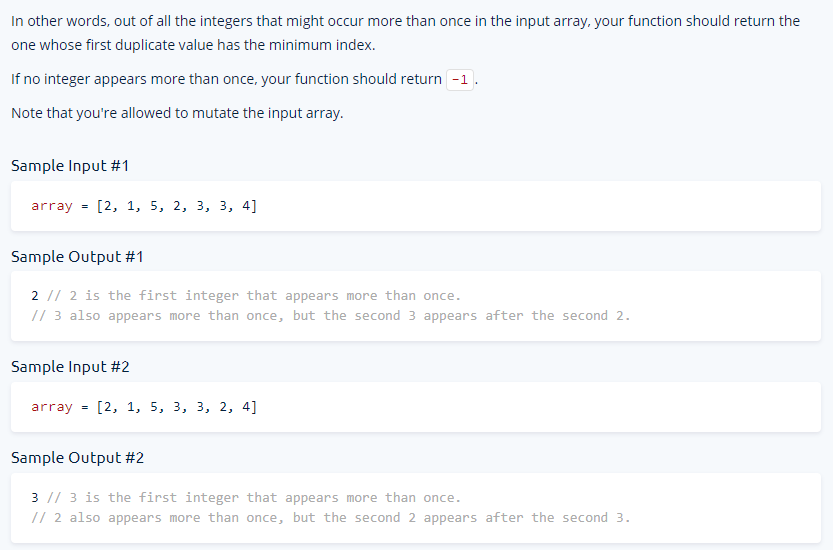
Javascript Solution
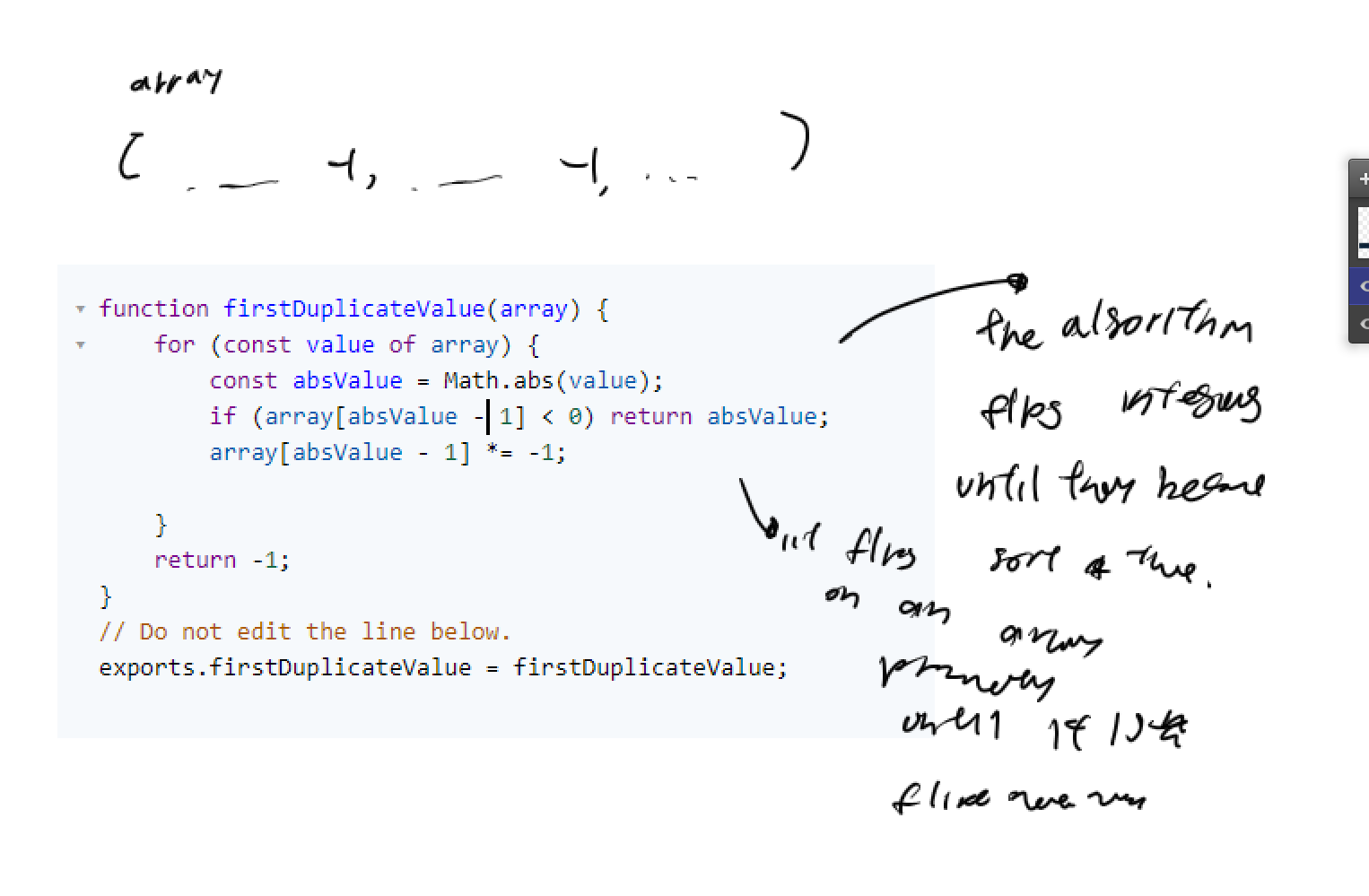
function firstDuplicateValue(array) {
for (const value of array) {
const absValue = Math.abs(value);
if (array[absValue - 1] < 0) return absValue;
array[absValue - 1] *= -1;
}
return -1;
}
9 - Merge Overlapping Intervals
Write a function that takes in a non-empty array of arbitrary intervals, merges any overalapping intervals, and returns the new intervals in no particular order.
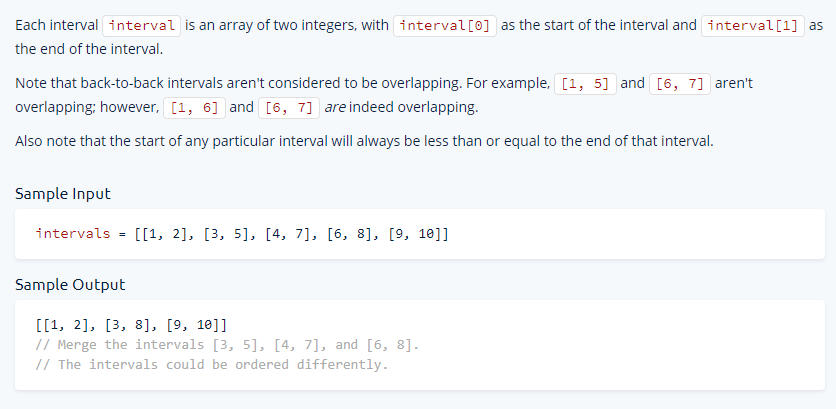
Javascript Solution
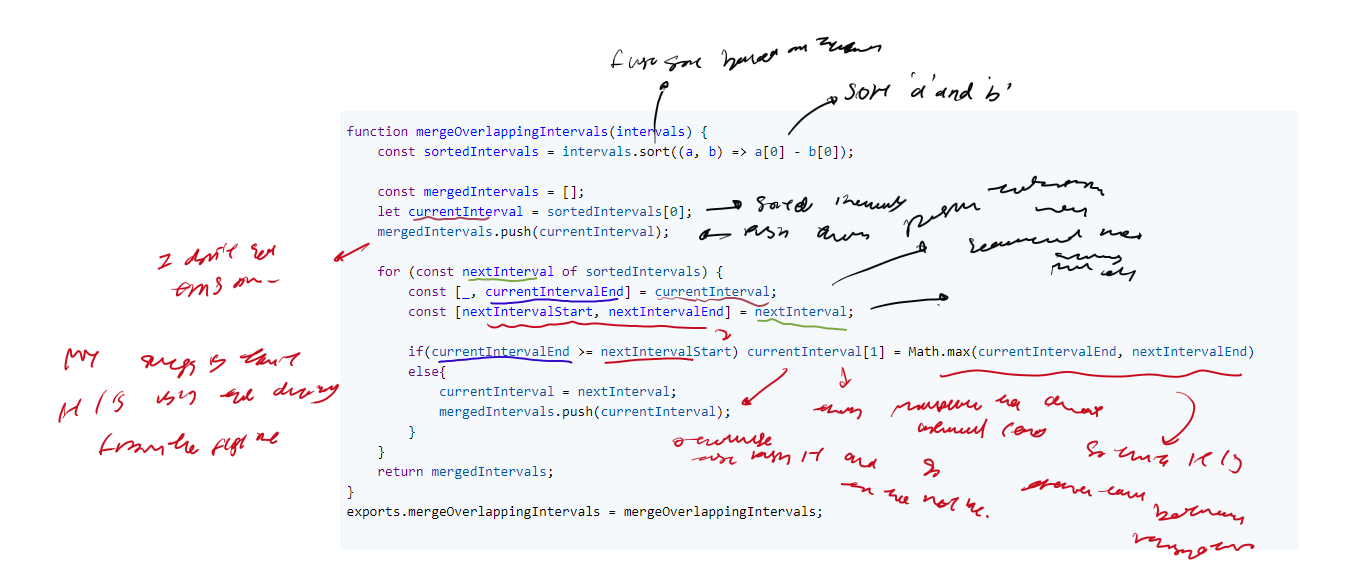
You can see how the first interval always goes on the merge list, since her values can be modiyied given that it is an array.
function mergeOverlappingIntervals(intervals) {
const sortedIntervals = intervals.sort((a, b) => a[0] - b[0]);
const mergedIntervals = [];
let currentInterval = sortedIntervals[0];
mergedIntervals.push(currentInterval);
for (const nextInterval of sortedIntervals) {
const [_, currentIntervalEnd] = currentInterval;
const [nextIntervalStart, nextIntervalEnd] = nextInterval;
if(currentIntervalEnd >= nextIntervalStart) currentInterval[1] = Math.max(currentIntervalEnd, nextIntervalEnd)
else{
currentInterval = nextInterval;
mergedIntervals.push(currentInterval);
}
}
return mergedIntervals;
}
10 - BST Contruction
Write a BST Class that supports insert, remove, and contains method
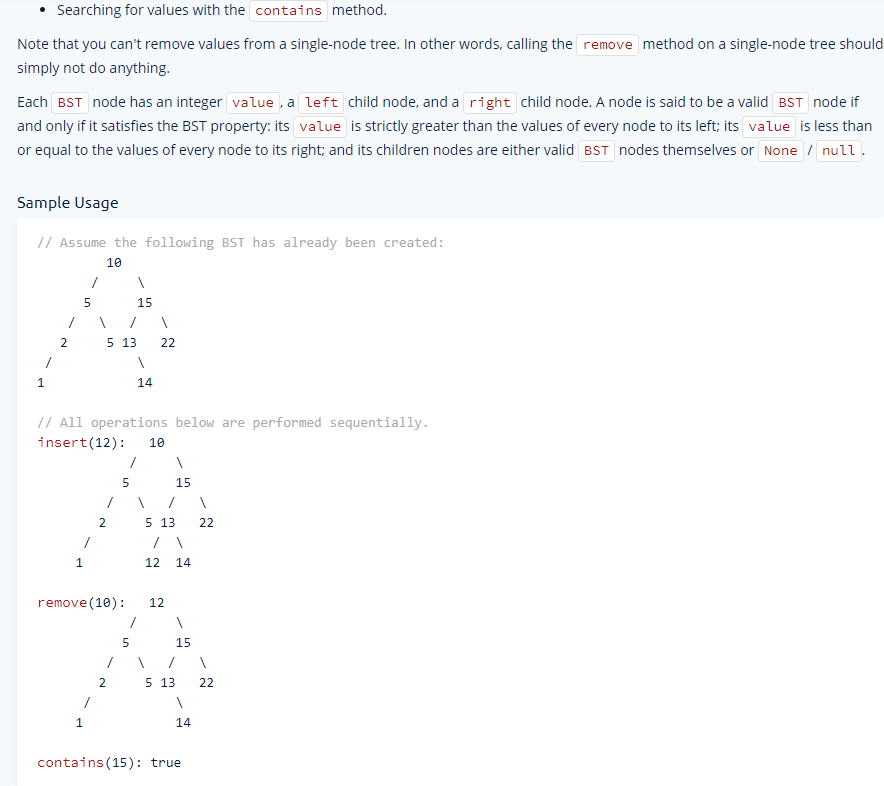
Javascript Solution
- You can observe how the first insertion recursively calls itself if it finds there is a value
- Also how the contains values checks right and left and returns false, only when it is null. It is optimized for binary search.
class BST {
constructor(value) {
this.value = value;
this.left = null;
this.right = null;
}
insert(value) {
// Write your code here.
// Do not edit the return statement of this method.
if (value < this.value) {
if (this.left === null) {
this.left = new BST(value);
} else {
this.left.insert(value);
}
} else {
if (this.right === null) {
this.right = new BST(value);
} else {
this.right.insert(value);
}
}
return this;
}
contains(value) {
// Write your code here.
if (value < this.value) {
if (this.left === null) {
return false;
} else {
return this.left.contains(value);
}
} else if (value > this.value) {
if (this.right === null) {
return false;
} else {
return this.right.contains(value);
}
} else {
return (true);
}
}
remove(value, parent = null) {
if (value < this.value) {
if (this.left !== null) {
this.left.remove(value, this);
}
} else if (value > this.value) {
if (this.right !== null) {
this.right.remove(value, this);
}
} else {
if (this.left !== null && this.right !== null) {
this.value = this.right.getMinValue();
this.right.remove(this.value, this);
} else if (parent === null) {
if (this.left !== null) {
this.value = this.left.value;
this.right = this.left.right;
this.left = this.left.left;
} else if (this.right !== null) {
this.value = this.right.value;
this.left = this.right.left;
this.right = this.right.right;
} else {
}
} else if (parent.left === this) {
parent.left = this.left !== null ? this.left : this.right;
} else if (parent.right === this) {
parent.right = this.left !== null ? this.left : this.right;
}
}
return this;
}
getMinValue() {
if (this.left == null) {
return this.value;
} else {
return this.left.getMinValue();
}
}
}
// Do not edit the line below.
exports.BST = BST;
11 - Validate BST
Write a function that takes in a potentially invalid Binary Search Tree (BST)
and returns a boolean representing whther the BST is valid.
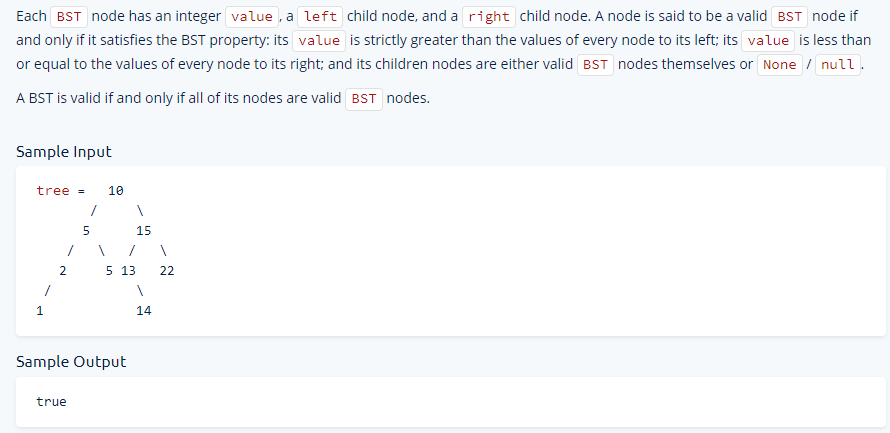
Javascript Solution
This is just about keep evaluating down the tree
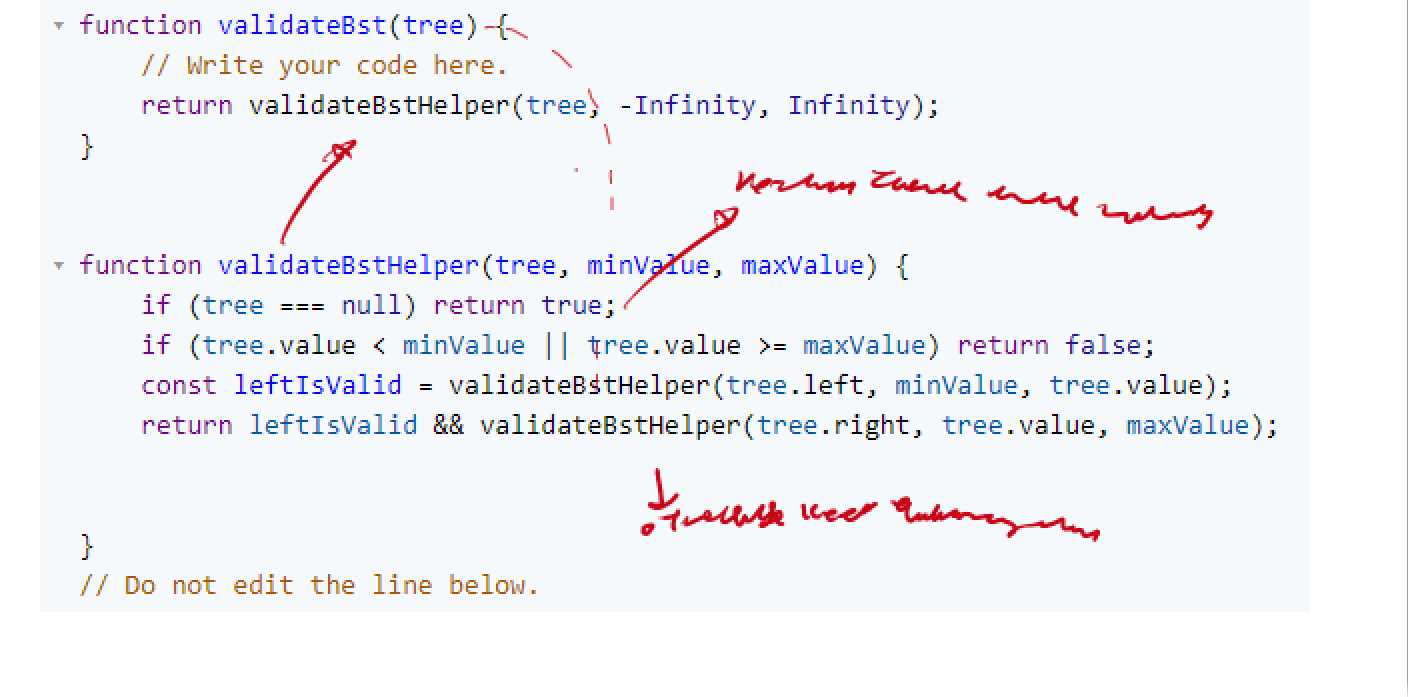
class BST {
constructor(value) {
this.value = value;
this.left = null;
this.right = null;
}
}
function validateBst(tree) {
// Write your code here.
return validateBstHelper(tree, -Infinity, Infinity);
}
function validateBstHelper(tree, minValue, maxValue) {
if (tree === null) return true;
if (tree.value < minValue || tree.value >= maxValue) return false;
const leftIsValid = validateBstHelper(tree.left, minValue, tree.value);
return leftIsValid && validateBstHelper(tree.right, tree.value, maxValue);
}
12 - BST Traversal
Write three functions that take in a Binary Search Tree (BST) and an empty array, traverse the BST, add its nodes' values to the input array, and returns that array. The three functions should traverse the BST using the in-order, pre-order, and post-order tree-traversal techniques, respectively.
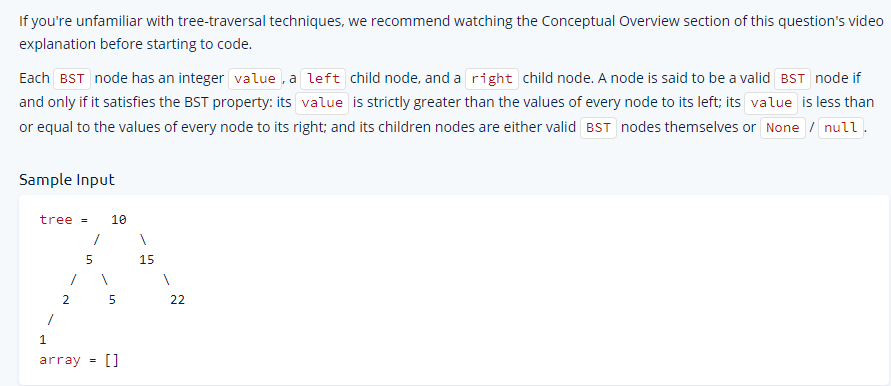
Javascript Solution
You can see here how the pre, post, in order traversals affect them.
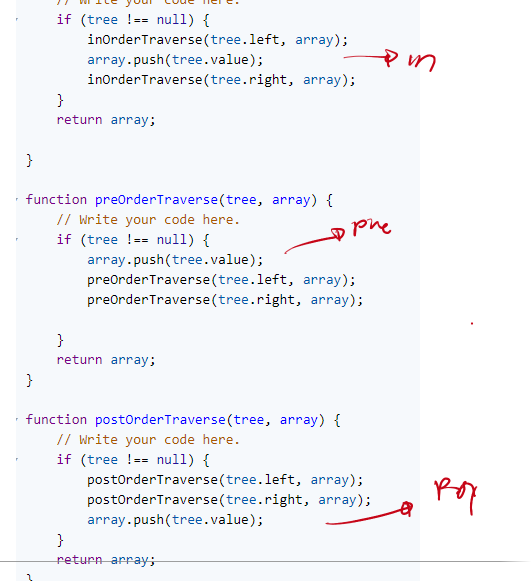
function inOrderTraverse(tree, array) {
// Write your code here.
if (tree !== null) {
inOrderTraverse(tree.left, array);
array.push(tree.value);
inOrderTraverse(tree.right, array);
}
return array;
}
function preOrderTraverse(tree, array) {
// Write your code here.
if (tree !== null) {
array.push(tree.value);
preOrderTraverse(tree.left, array);
preOrderTraverse(tree.right, array);
}
return array;
}
function postOrderTraverse(tree, array) {
// Write your code here.
if (tree !== null) {
postOrderTraverse(tree.left, array);
postOrderTraverse(tree.right, array);
array.push(tree.value);
}
return array;
}
13 - Min Height BST
Write a function that takes in a non-empty sorted array of distinct integers,
contructs a BST from the integers, and returns the root of the BST
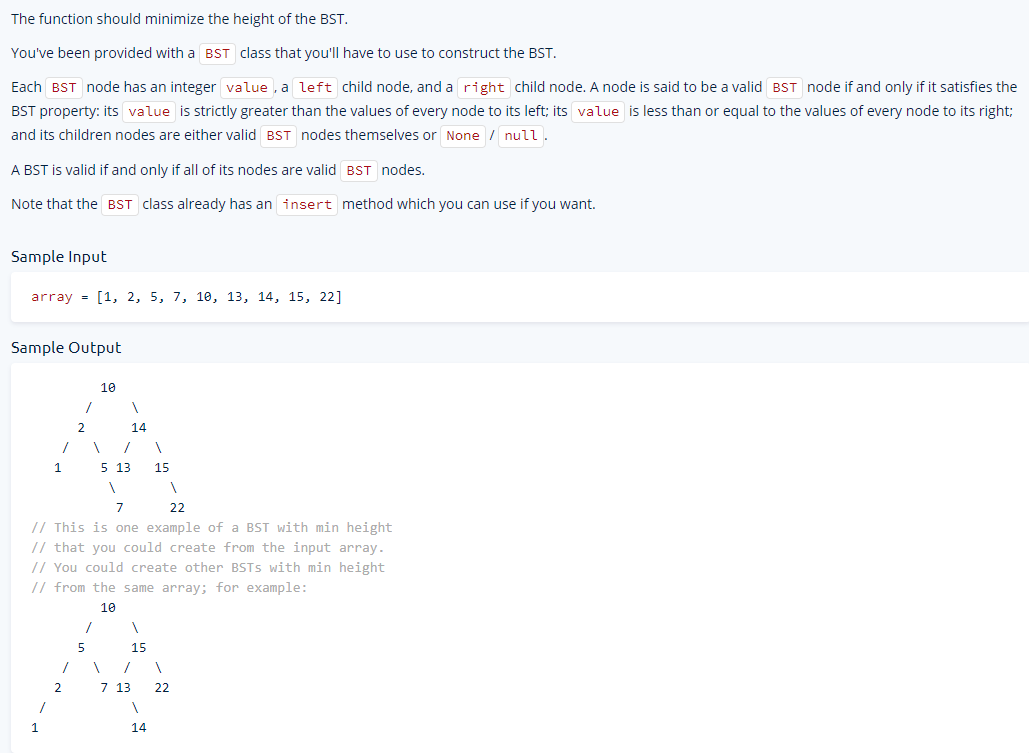
Starter Code
function minHeightBst(array) {
// Write your code here.
}
class BST {
constructor(value) {
this.value = value;
this.left = null;
this.right = null;
}
insert(value) {
if (value < this.value) {
if (this.left === null) {
this.left = new BST(value);
} else {
this.left.insert(value);
}
} else {
if (this.right === null) {
this.right = new BST(value);
} else {
this.right.insert(value);
}
}
}
}
// Do not edit the line below.
exports.minHeightBst = minHeightBst;
https://replit.com/join/ffpqgpxtqr-nenewang
https://www.algoexpert.io/questions/min-height-bst
Javascript Solution
function minHeightBst(array) {
// Write your code here.
return constructMinHeightBst(array, null, 0, array.length - 1);
}
function constructMinHeightBst(array, bst, startIdx, endIdx) {
if (endIdx < startIdx) return;
const midIdx = Math.floor((startIdx + endIdx) / 2);
const valueToAdd = array[midIdx];
if (bst === null) {
bst = new BST(valueToAdd);
} else {
bst.insert(valueToAdd);
}
constructMinHeightBst(array, bst, startIdx, midIdx - 1);
constructMinHeightBst(array, bst, midIdx + 1, endIdx);
return bst;
}
class BST {
constructor(value) {
this.value = value;
this.left = null;
this.right = null;
}
insert(value) {
if (value < this.value) {
if (this.left === null) {
this.left = new BST(value);
} else {
this.left.insert(value);
}
} else {
if (this.right === null) {
this.right = new BST(value);
} else {
this.right.insert(value);
}
}
}
}
14 - Find Kth Largest Value in BST
Write a function that takes in a Binary Search Tree (BST) and a positive integer k and returns the kth largest integer contained in the BST.
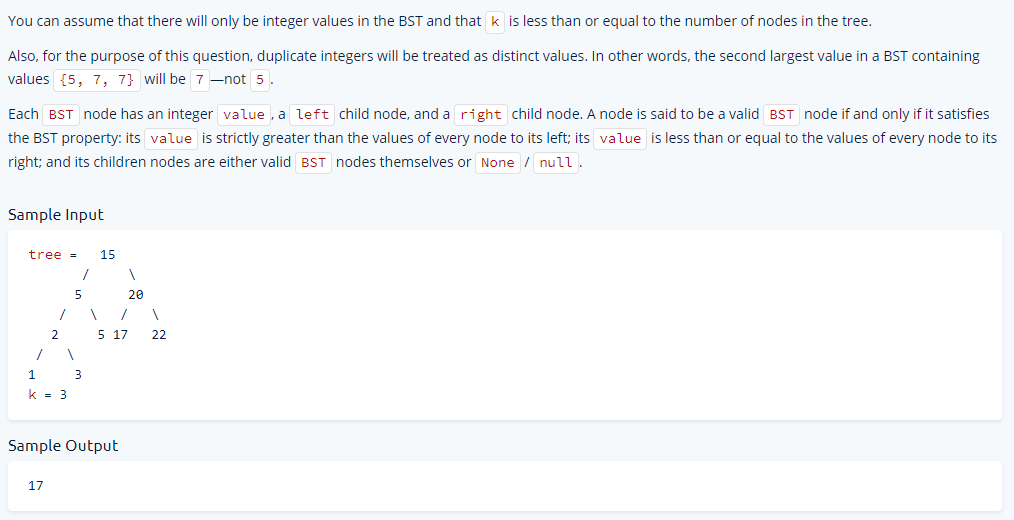
Starter Code
// This is an input class. Do not edit.
class BST {
constructor(value) {
this.value = value;
this.left = null;
this.right = null;
}
}
function findKthLargestValueInBst(tree, k) {
// Write your code here.
return -1;
}
Javascript Solution (Naive)
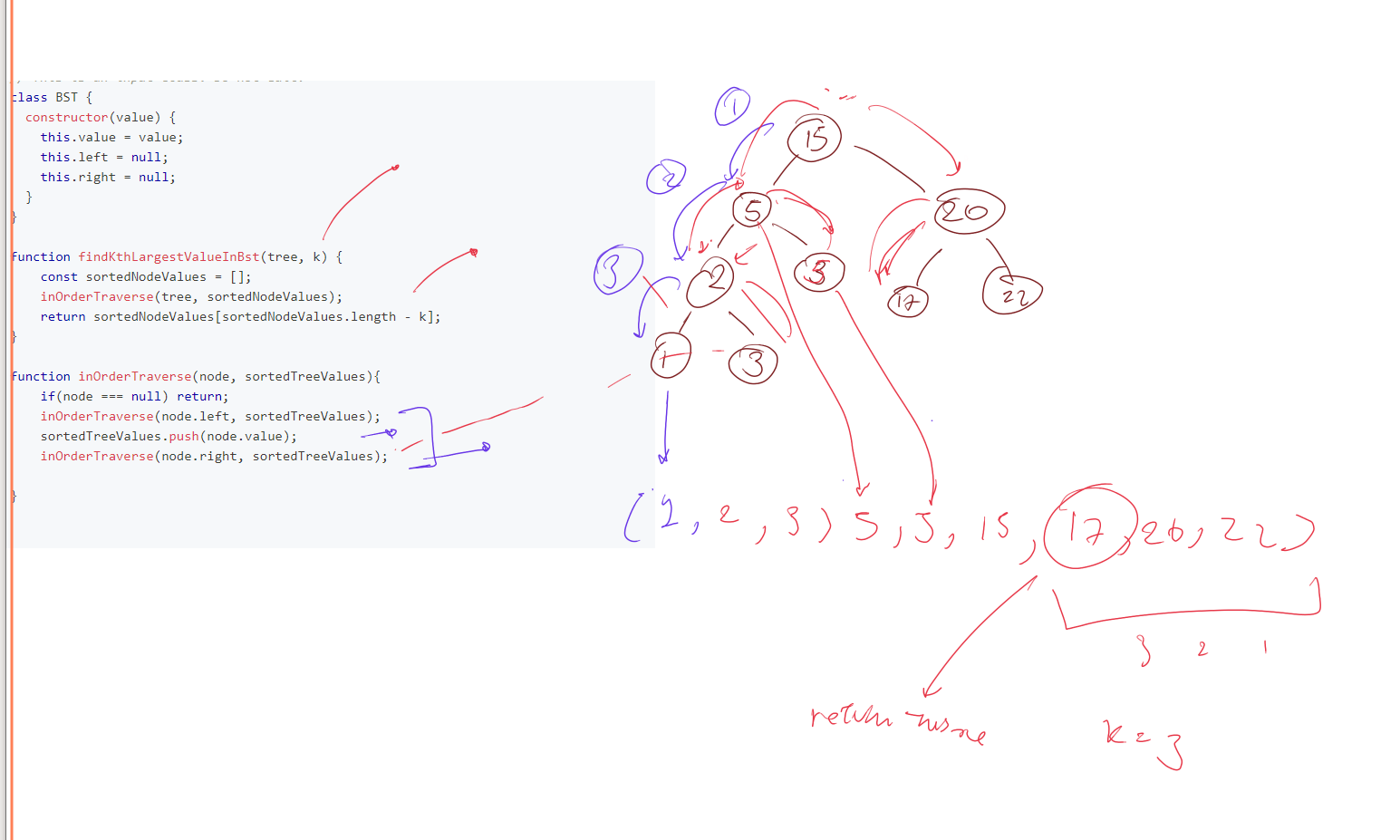
// This is an input class. Do not edit.
class BST {
constructor(value) {
this.value = value;
this.left = null;
this.right = null;
}
}
function findKthLargestValueInBst(tree, k) {
const sortedNodeValues = [];
inOrderTraverse(tree, sortedNodeValues);
return sortedNodeValues[sortedNodeValues.length - k];
}
function inOrderTraverse(node, sortedTreeValues){
if(node === null) return;
inOrderTraverse(node.left, sortedTreeValues);
sortedTreeValues.push(node.value);
inOrderTraverse(node.right, sortedTreeValues);
}
Javascript Solution (Efficient)
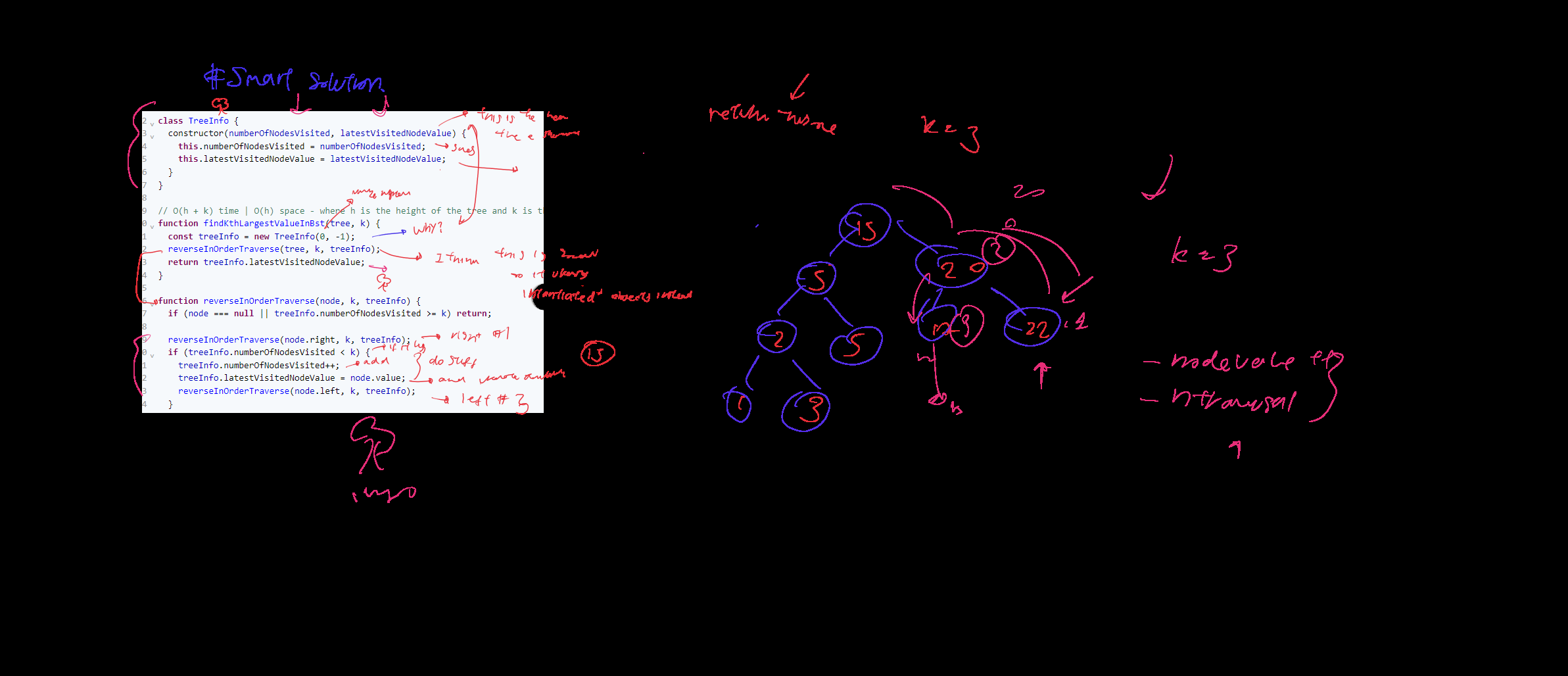
// This is an input class. Do not edit.// This is an input class. Do not edit.
class BST {
constructor(value) {
this.value = value;
this.left = null;
this.right = null;
}
}
class TreeInfo{
constructor(travesalN, lastNode){
this.travesalN = travesalN;
this.lastNode = lastNode;
}
}
function findKthLargestValueInBst(tree, k) {
const treeInfo = new TreeInfo(0, -1)
reverseOrderTravesal(tree, treeInfo, k)
return treeInfo.lastNode;
}
function reverseOrderTravesal(node, treeInfo, k){
if(node==null || treeInfo.travesalN >= k){
return
}
// right
reverseOrderTravesal(node.right, treeInfo, k)
// Do something
if(treeInfo.travesalN < k){
treeInfo.travesalN++
treeInfo.lastNode = node.value
}
// Left
reverseOrderTravesal(node.left, treeInfo, k)
}
15 - Reconstruct BST
The pre-order traversal of a Binary Tree is a traversal technique that starts at the tree's root node and visits nodes in the following order:
- Current node
- Left subtree
- Right subtree
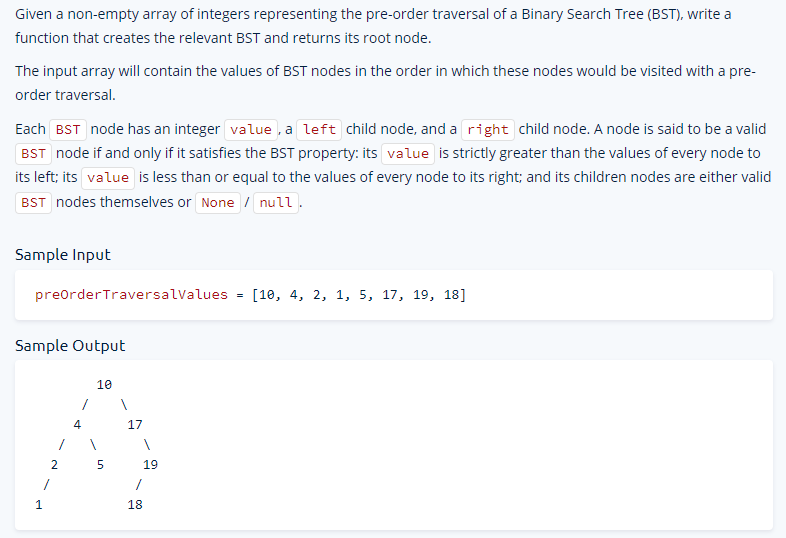
Starter Code
// This is an input class. Do not edit.
class BST {
constructor(value, left = null, right = null) {
this.value = value;
this.left = left;
this.right = right;
}
}
function reconstructBst(preOrderTraversalValues) {
// Write your code here.
return null;
}
👨🔬 Javascript Solution
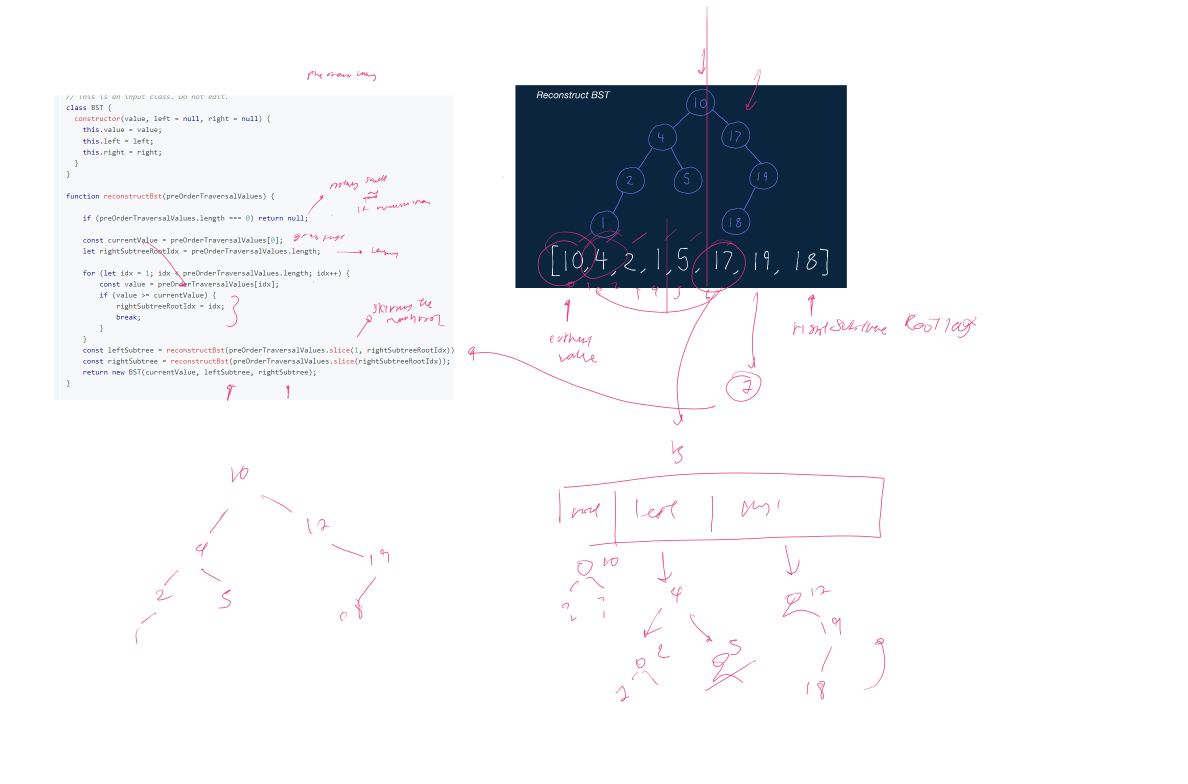
// This is an input class. Do not edit.
// This is an input class. Do not edit.
class BST {
constructor(value, left = null, right = null) {
this.value = value;
this.left = left;
this.right = right;
}
}
function reconstructBst(preOrderTraversalValues) {
if (preOrderTraversalValues.length === 0) return null;
const currentValue = preOrderTraversalValues[0];
let rightSubtreeRootIdx = preOrderTraversalValues.length;
for (let idx = 1; idx < preOrderTraversalValues.length; idx++) {
const value = preOrderTraversalValues[idx];
if (value >= currentValue) {
rightSubtreeRootIdx = idx;
break;
}
}
const leftSubtree = reconstructBst(preOrderTraversalValues.slice(1, rightSubtreeRootIdx));
const rightSubtree = reconstructBst(preOrderTraversalValues.slice(rightSubtreeRootIdx));
return new BST(currentValue, leftSubtree, rightSubtree);
}